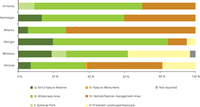
It illustrates proportional distribution of coverage of nationally protected areas according to the IUCN protected areas management categories.

The Map illustrates with the dark green those sites proposed, adopted or already included into the Emerald Network of the Bern Convention.

Despite a strong policy framework and significant efforts by Member States (MSs) to halt biodiversity loss and ecosystem degradation in Europe, the conservation status of protected species and habitats continues to decline along with the provision of ecosystem services. The new EU biodiversity strategy to 2030 addresses this decline with a plan to ‘build a truly coherent Trans-European Nature Network’. This will be built on the existing Natura 2000 network by analysing the potential connectivity between Natura 2000 sites using green infrastructure (GI) landscape elements important for delivering ecosystem services.

The European Union’s (EU) network of protected sites, Natura 2000, could be further connected with green infrastructure to create a trans-European nature network. According to a European Environment Agency (EEA) briefing, published today, highways and other infrastructure currently disconnect about 15 % of the Natura 2000 sites from other nature areas, reducing their capacity for ecosystem services.

Despite a strong policy framework and significant efforts by Member States (MSs) to halt biodiversity loss and ecosystem degradation in Europe, the conservation status of protected species and habitats continues to decline along with the provision of ecosystem services. The new EU biodiversity strategy to 2030 addresses this decline with a plan to ‘build a truly coherent Trans-European Nature Network’. This will be built on the existing Natura 2000 network by analysing the potential connectivity between Natura 2000 sites using green infrastructure (GI) landscape elements important for delivering ecosystem services.

Faced with the increased threats posed by overexploitation of marine resources, pollution and climate change, urgent action is needed to bring Europe’s seas back to good condition. According to the European Environment Agency’s report on Europe’s marine ecosystems, published today, we are running out of time to reverse decades of neglect and misuse.

This report provides a set of key messages on the current use of Europe's seas and its combined effects on marine ecosystem condition. These messages underpin a set of lessons from marine ecosystem recovery from which solutions for a brighter future can be identified.

This indicator shows the current status of implementation of the Habitats Directive (92/43/EEC) and the Birds Directive (79/409/EEC) by EU Member States. It does this by showing trends in spatial coverage of special protection areas (SPAs) designated under the Birds Directive, sites and proposed sites of Community importance (SCIs) and special areas of conservation (SACs) designated under the Habitats Directive, as well as the net area of the Natura 2000 network.
The net percentage of Natura 2000 areas helps to evaluate progress in reaching Aichi Target 11.


The European Commission has adopted the new EU Biodiversity Strategy for 2030 and an associated Action Plan (annex) - a comprehensive, ambitious, long-term plan for protecting nature and reversing the degradation of ecosystems.
It aims to put Europe's biodiversity on a path to recovery by 2030 with benefits for people, the climate and the planet. It aims to build our societies’ resilience to future threats such as climate change impacts, forest fires, food insecurity or disease outbreaks, including by protecting wildlife and fighting illegal wildlife trade.
A core part of the European Green Deal , the Biodiversity Strategy will also support a green recovery following the COVID-19 pandemic.

to be deleted;
Correct record is here: https://www.eea.europa.eu/policy-documents/eu-biodiversity-strategy-for-2030-1/view?portal_status_message=Changes%20saved.

The map shows the loss and gain of forests aggregated in a 10 km grid. Units are in ha/km2.
The following CLC classes were used:
Consumption of transitional woodland (LCF71),
Consumption caused by forest and shrub fires (LCF92),
Consumption caused by forest management (LCF74),
Afforestation (LCF72),
Forest-internal conversion (LCF71, LCF73 and part of LCF74),
Withdrawal of farming with woodland creation (LCF61),
Total formation of forest.

Land take as a result of urban sprawl is measured from the Copernicus Corine Land Cover dataset between 2000-2018. The map shows for each grid cell the area in km2 which was converted to urban areas. For visualization land take data is presented in a 10km grid. The original data which statistics are derived from is from the 100m spatial resolution CLC dataset series.

The map shows the loss and gain of arable land and permanent crops aggregated in a 10 km grid.
The following CLC classes were used:
211 Non-irrigated arable land,
212 Permanently irrigated land,
213 Rice fields,
221 Vineyards,
222 Fruit trees and berry plantations,
223 Olive groves,
241 Annual crops associated with permanent crops.

No matter where we are, we can all appreciate the wonders of nature, now possibly more than ever. This year’s European Environment Agency (EEA) photo competition ‘REDISCOVER Nature’, which opens today, invites you to capture and share your bond with nature and the environment around you.

Yearly vegetation productivity during 2000-2016 are analyzed in areas under drought pressure, measured as precipitation shortages and low soil moisture content. Vegetation productivity values are disaggregated and detailed by year and by detailed land cover categories. Strong negative values indicate strong drought intensity, with vegetation productivity values lower than the long term average normal condition.
Scroll down to the More information section for further details.

The ecological footprint of Europe is a proxy measure of the amount of biologically productive land and water areas that Europe requires to produce all the biological resources it consumes and to absorb the emissions it generates, using prevailing technology and management strategies. These areas could be located anywhere in the world. This can be compared with the biocapacity of the planet or the biocapacity available within a given region.

This dashboard provides numbers of Annex II species being nationally hunted
Document Actions
Share with others